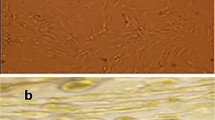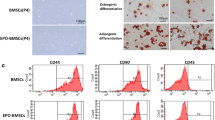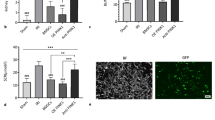Abstract
Background
Acute kidney injury (AKI) leads to serious renal damage, and early inhibition of inflammation is necessary for its treatment. C5a/C5aR signaling activation promotes inflammatory response in tissue injury. Anti-inflammatory activity of mesenchymal stem cells (MSCs) makes it possible to alleviate AKI by controlling the C5a/C5aR signaling activation.
Methods
Ischemia reperfusion (I/R)-induced AKI models in wild-type and C5aR KO mice were used. In addition, human bone marrow MSCs (hBM-MSCs) or C5aR antagonist were injected in this model. All animals were killed at 72 h after reperfusion. In vitro, the LPS-activated macrophage line RAW264.7 cells were co-cultured with or without hBM-MSCs in the presence of recombinant C5a or not for indicated time points. After that, C5aR expression, the inflammatory factor production, and NF-κB translocation in RAW264.7 cells were measured.
Results
hBM-MSC treatment and C5a/C5aR signaling blockade or C5aR-deficiency exhibited similar attenuated effects on I/R-induced AKI, macrophages infiltration, and the pro-inflammatory cytokines TNF-α and IL-1β expression in renal tissues in mice. Moreover, hBM-MSC administration led to a significant reduction in C5a levels in serum and C5aR expression in the kidney tissues in mice after I/R. In vitro, upon co-culture with hBM-MSCs, both C5aR expression and the secretion of pro-inflammatory factors TNF-α, IL-6, and nitric oxide in LPS-activated macrophages were markedly reduced. Accordingly, recombinant complement C5a accelerated LPS-induced NF-κB translocation and pro-inflammatory factors expression in macrophages, but the addition of hBM-MSCs reversed these C5a-induced effects.
Conclusions
The present study indicates that hBM-MSCs alleviate AKI via suppressing C5a/C5aR-NF-κB pathway activation.




Similar content being viewed by others
References
Zhou M, Tang W, Fu Y, Xu X, Wang Z, Lu Y, Liu F, Yang X, Wei X, Zhang Y, Liu J, Geng X, Zhang C, Wan Q, Li N, Yi F (2015) Progranulin protects against renal ischemia/reperfusion injury in mice. Kidney Int 87(5):918–929. https://doi.org/10.1038/ki.2014.403
Lu H, Bai Y, Wu L, Hong W, Liang Y, Chen B, Bai Y (2016) Inhibition of macrophage migration inhibitory factor protects against inflammation and matrix deposition in kidney tissues after injury. Mediat Inflamm 2016:2174682. https://doi.org/10.1155/2016/2174682
Ylostalo JH, Bartosh TJ, Coble K, Prockop DJ (2012) Human mesenchymal stem/stromal cells cultured as spheroids are self-activated to produce prostaglandin E2 that directs stimulated macrophages into an anti-inflammatory phenotype. Stem Cells 30(10):2283–2296. https://doi.org/10.1002/stem.1191
Prockop DJ, Oh JY (2012) Mesenchymal stem/stromal cells (MSCs): role as guardians of inflammation. Mol Ther J Am Soc Gene Ther 20(1):14–20. https://doi.org/10.1038/mt.2011.211
Hu J, Zhang L, Wang N, Ding R, Cui S, Zhu F, Xie Y, Sun X, Wu D, Hong Q, Li Q, Shi S, Liu X, Chen X (2013) Mesenchymal stem cells attenuate ischemic acute kidney injury by inducing regulatory T cells through splenocyte interactions. Kidney Int 84(3):521–531. https://doi.org/10.1038/ki.2013.114
Sala E, Genua M, Petti L, Anselmo A, Arena V, Cibella J, Zanotti L, D’Alessio S, Scaldaferri F, Luca G, Arato I, Calafiore R, Sgambato A, Rutella S, Locati M, Danese S, Vetrano S (2015) Mesenchymal Stem Cells Reduce Colitis in Mice via Release of TSG6, Independently of Their Localization to the Intestine. Gastroenterology 149(1):163–176 e120. https://doi.org/10.1053/j.gastro.2015.03.013
Mora-Lee S, Sirerol-Piquer MS, Gutierrez-Perez M, Gomez-Pinedo U, Roobrouck VD, Lopez T, Casado-Nieto M, Abizanda G, Rabena MT, Verfaille C, Prosper F, Garcia-Verdugo JM (2012) Therapeutic effects of hMAPC and hMSC transplantation after stroke in mice. PLoS ONE 7(8):e43683. https://doi.org/10.1371/journal.pone.0043683
Qi Y, Jiang D, Sindrilaru A, Stegemann A, Schatz S, Treiber N, Rojewski M, Schrezenmeier H, Vander Beken S, Wlaschek M, Bohm M, Seitz A, Scholz N, Durselen L, Brinckmann J, Ignatius A, Scharffetter-Kochanek K (2014) TSG-6 released from intradermally injected mesenchymal stem cells accelerates wound healing and reduces tissue fibrosis in murine full-thickness skin wounds. J Invest Dermatol 134(2):526–537. https://doi.org/10.1038/jid.2013.328
Oh JY, Lee RH, Yu JM, Ko JH, Lee HJ, Ko AY, Roddy GW, Prockop DJ (2012) Intravenous mesenchymal stem cells prevented rejection of allogeneic corneal transplants by aborting the early inflammatory response. Mol Ther J Am Soc Gene Ther 20(11):2143–2152. https://doi.org/10.1038/mt.2012.165
Xu GL, Chen J, Yang F, Li GQ, Zheng LX, Wu YZ (2014) C5a/C5aR pathway is essential for the pathogenesis of murine viral fulminant hepatitis by way of potentiating Fgl2/fibroleukin expression. Hepatology 60(1):114–124. https://doi.org/10.1002/hep.27114
Berentsen S (2015) Role of complement in autoimmune hemolytic anemia. Transfusion medicine and hemotherapy: offizielles Organ der Deutschen Gesellschaft fur Transfusionsmedizin und Immunhamatologie 42(5):303–310. https://doi.org/10.1159/000438964
Sarma JV, Ward PA (2011) The complement system. Cell Tissue Res 343(1):227–235. https://doi.org/10.1007/s00441-010-1034-0
Phieler J, Chung KJ, Chatzigeorgiou A, Klotzsche-von Ameln A, Garcia-Martin R, Sprott D, Moisidou M, Tzanavari T, Ludwig B, Baraban E, Ehrhart-Bornstein M, Bornstein SR, Mziaut H, Solimena M, Karalis KP, Economopoulou M, Lambris JD, Chavakis T (2013) The complement anaphylatoxin C5a receptor contributes to obese adipose tissue inflammation and insulin resistance. J Immunol 191(8):4367–4374. https://doi.org/10.4049/jimmunol.1300038
Jacob A, Hack B, Chen P, Quigg RJ, Alexander JJ (2011) C5a/CD88 signaling alters blood–brain barrier integrity in lupus through nuclear factor-κB. J Neurochem 119(5):1041–1051. https://doi.org/10.1111/j.1471-4159.2011.07490.x
Lappas M, Woodruff TM, Taylor SM, Permezel M (2012) Complement C5A regulates prolabor mediators in human placenta. Biol Reprod 86(6):190. https://doi.org/10.1095/biolreprod.111.098475
Cao S, Wang JC, Gao J, Wong M, To E, White VA, Cui JZ, Matsubara JA (2016) CFH Y402H polymorphism and the complement activation product C5a: effects on NF-κB activation and inflammasome gene regulation. Br J Ophthalmol 100(5):713–718. https://doi.org/10.1136/bjophthalmol-2015-307213
Peng Q, Li K, Smyth LA, Xing G, Wang N, Meader L, Lu B, Sacks SH, Zhou W (2012) C3a and C5a promote renal ischemia-reperfusion injury. J Am Soc Nephrol JASN 23(9):1474–1485. https://doi.org/10.1681/ASN.2011111072
Vlaicu SI, Tatomir A, Boodhoo D, Vesa S, Mircea PA, Rus H (2016) The role of complement system in adipose tissue-related inflammation. Immunol Res. https://doi.org/10.1007/s12026-015-8783-5
Iyer A, Woodruff TM, Wu MC, Stylianou C, Reid RC, Fairlie DP, Taylor SM, Brown L (2011) Inhibition of inflammation and fibrosis by a complement C5a receptor antagonist in DOCA-salt hypertensive rats. J Cardiovasc Pharmacol 58(5):479–486. https://doi.org/10.1097/FJC.0b013e31822a7a09
Kastl SP, Speidl WS, Kaun C, Rega G, Assadian A, Weiss TW, Valent P, Hagmueller GW, Maurer G, Huber K, Wojta J (2006) The complement component C5a induces the expression of plasminogen activator inhibitor-1 in human macrophages via NF-κB activation. J Thromb Haemost JTH 4(8):1790–1797. https://doi.org/10.1111/j.1538-7836.2006.02046.x
Lai LW, Yong KC, Lien YH (2012) Pharmacologic recruitment of regulatory T cells as a therapy for ischemic acute kidney injury. Kidney Int 81(10):983–992. https://doi.org/10.1038/ki.2011.412
Xi W, Liu L, Wang J, Xia Y, Bai Q, Long Q, Wang Y, Xu J, Guo J (2016) High level of anaphylatoxin C5a predicts poor clinical outcome in patients with clear cell renal cell carcinoma. Sci Rep 6:29177. https://doi.org/10.1038/srep29177
Danobeitia JS, Djamali A, Fernandez LA (2014) The role of complement in the pathogenesis of renal ischemia-reperfusion injury and fibrosis. Fibrogenesis Tissue Repair 7:16. https://doi.org/10.1186/1755-1536-7-16
Seow V, Lim J, Iyer A, Suen JY, Ariffin JK, Hohenhaus DM, Sweet MJ, Fairlie DP (2013) Inflammatory responses induced by lipopolysaccharide are amplified in primary human monocytes but suppressed in macrophages by complement protein C5a. J Immunol 191(8):4308–4316. https://doi.org/10.4049/jimmunol.1301355
Jang HR, Rabb H (2015) Immune cells in experimental acute kidney injury. Nat Rev Nephrol 11(2):88–101. https://doi.org/10.1038/nrneph.2014.180
Christian F, Smith EL, Carmody RJ (2016) The regulation of NF-κB subunits by phosphorylation. Cells 5(1):12. https://doi.org/10.3390/cells5010012
Lee RH, Pulin AA, Seo MJ, Kota DJ, Ylostalo J, Larson BL, Semprun-Prieto L, Delafontaine P, Prockop DJ (2009) Intravenous hMSCs improve myocardial infarction in mice because cells embolized in lung are activated to secrete the anti-inflammatory protein TSG-6. Cell Stem Cell 5(1):54–63. https://doi.org/10.1016/j.stem.2009.05.003
Jung KH, Song SU, Yi T, Jeon MS, Hong SW, Zheng HM, Lee HS, Choi MJ, Lee DH, Hong SS (2011) Human bone marrow-derived clonal mesenchymal stem cells inhibit inflammation and reduce acute pancreatitis in rats. Gastroenterology 140(3):998–1008. https://doi.org/10.1053/j.gastro.2010.11.047
Niemeyer P, Szalay K, Luginbuhl R, Sudkamp NP, Kasten P (2010) Transplantation of human mesenchymal stem cells in a non-autogenous setting for bone regeneration in a rabbit critical-size defect model. Acta Biomater 6(3):900–908. https://doi.org/10.1016/j.actbio.2009.09.007
Xing L, Cui R, Peng L, Ma J, Chen X, Xie RJ, Li B (2014) Mesenchymal stem cells, not conditioned medium, contribute to kidney repair after ischemia-reperfusion injury. Stem Cell Res Ther 5(4):101. https://doi.org/10.1186/scrt489
Zhang X, Lewkowich IP, Kohl G, Clark JR, Wills-Karp M, Kohl J (2009) A protective role for C5a in the development of allergic asthma associated with altered levels of B7-H1 and B7-DC on plasmacytoid dendritic cells. J Immunol 182(8):5123–5130. https://doi.org/10.4049/jimmunol.0804276
Brennan FH, Gordon R, Lao HW, Biggins PJ, Taylor SM, Franklin RJ, Woodruff TM, Ruitenberg MJ (2015) The complement receptor C5aR controls acute inflammation and astrogliosis following spinal cord injury. J Neurosci Off J Soc Neurosci 35(16):6517–6531. https://doi.org/10.1523/JNEUROSCI.5218-14.2015
Mueller M, Herzog C, Larmann J, Schmitz M, Hilfiker-Kleiner D, Gessner JE, Theilmeier G (2013) The receptor for activated complement factor 5 (C5aR) conveys myocardial ischemic damage by mediating neutrophil transmigration. Immunobiology 218(9):1131–1138. https://doi.org/10.1016/j.imbio.2013.03.006
Hu R, Chen ZF, Yan J, Li QF, Huang Y, Xu H, Zhang X, Jiang H (2014) Complement C5a exacerbates acute lung injury induced through autophagy-mediated alveolar macrophage apoptosis. Cell Death Dis 5:e1330. https://doi.org/10.1038/cddis.2014.274
Zhang K, Li GQ, He QH, Li Y, Tang M, Zheng QY, Xu GL, Zhang KQ (2017) C5a/C5aR pathway accelerates renal ischemia-reperfusion injury by downregulating PGRN expression. Int Immunopharmacol 53:17–23. https://doi.org/10.1016/j.intimp.2017.10.006
Cheng H, Fan X, Lawson WE, Paueksakon P, Harris RC (2015) Telomerase deficiency delays renal recovery in mice after ischemia-reperfusion injury by impairing autophagy. Kidney Int. https://doi.org/10.1038/ki.2015.69
Marko L, Vigolo E, Hinze C, Park JK, Roel G, Balogh A, Choi M, Wubken A, Cording J, Blasig IE, Luft FC, Scheidereit C, Schmidt-Ott KM, Schmidt-Ullrich R, Muller DN (2016) Tubular epithelial NF-κB activity regulates ischemic AKI. J Am Soc Nephrol JASN 27(9):2658–2669. https://doi.org/10.1681/ASN.2015070748
Raish M, Ahmad A, Ansari MA, Alkharfy KM, Aljenoobi FI, Jan BL, Al-Mohizea AM, Khan A, Ali N (2018) Momordica charantia polysaccharides ameliorate oxidative stress, inflammation, and apoptosis in ethanol-induced gastritis in mucosa through NF-kB signaling pathway inhibition. Int J Biol Macromol 111:193–199. https://doi.org/10.1016/j.ijbiomac.2018.01.008
Wan X, Fan L, Hu B, Yang J, Li X, Chen X, Cao C (2011) Small interfering RNA targeting IKKbeta prevents renal ischemia-reperfusion injury in rats. Am J Physiol Renal Physiol 300(4):F857–F863. https://doi.org/10.1152/ajprenal.00547.2010
Hocherl K, Schmidt C, Kurt B, Bucher M (2010) Inhibition of NF-κB ameliorates sepsis-induced downregulation of aquaporin-2/V2 receptor expression and acute renal failure in vivo. Am J Physiol Renal Physiol 298(1):F196–F204. https://doi.org/10.1152/ajprenal.90607.2008
Acknowledgements
This work was supported by National Natural Science Foundation of China (No. 81370846).
Author information
Authors and Affiliations
Contributions
MT is acknowledged for study design, acquisition of data, statistical analysis, and drafting of the manuscript; KZ, YL, QZ, QH, and GL for technical and material support; KQZ for study design, analysis, and interpretation of data, writing, and revision of the article. All authors read and approved the final manuscript.
Corresponding author
Ethics declarations
Conflict of interest
The authors declare that they have no conflict of interest.
Ethical approval
All procedures performed in studies involving animals were in accordance with the ethical standards of the Institutional Animal Care and Use Committee of the Third Military Medical University at which the studies were conducted.
Electronic supplementary material
Below is the link to the electronic supplementary material.
Rights and permissions
About this article
Cite this article
Tang, M., Zhang, K., Li, Y. et al. Mesenchymal stem cells alleviate acute kidney injury by down-regulating C5a/C5aR pathway activation. Int Urol Nephrol 50, 1545–1553 (2018). https://doi.org/10.1007/s11255-018-1844-7
Received:
Accepted:
Published:
Issue Date:
DOI: https://doi.org/10.1007/s11255-018-1844-7




